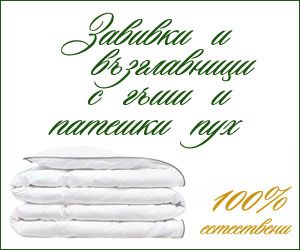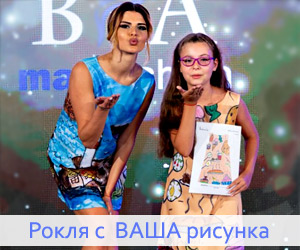Alberta Ferretti: romanticism and luxury, femininity and sex appeal
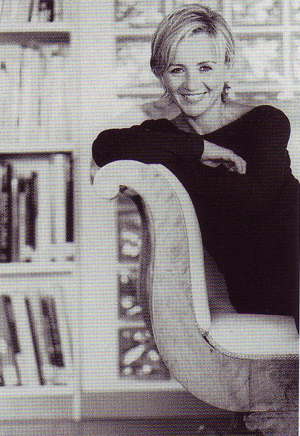 Alberta Ferretti was born in 1950 in Cattolica, Italy. She opened her own boutique named Jolly in 1968 and started selling clothes of the not so well known at that time fashion designers Gianni Versace, Giorgio Armani, Mariuccia Mandelli among others. In 1974 she created her first brand and showed in her native town her first collection which had a tremendous success. In 1980 she and her brother Massimo established Aeffe company (the name is compiled from the designer’s initials), and a year later she organized her first fashion show in Milan as well. In the same year she signed a contract for joint activity with up–and–coming designer Enrico Coveri. In 1984 she started developing her two main lines Alberta Ferretti and Philosophy. Five years later she launched jeans clothes of the Ferretti Jeans Philosophy brand, which in 1994 turned into a prêt–a–porter division called Philosophy di Alberta Ferretti. The fact that Alberta Ferretti starts production of clothing for famous fashion houses such as Jean Paul Gaultier, Franco Moschino, Rifat Ozbek and Narciso Rodriguez is a serious sign for the growth of the company. This happened in 1990s. The corporate data from 1998 showed unambiguously a serious growth in the dynamics of the company: it had 580 employees, and its turnover is 277 billion pounds. Next year, Alberta Ferretti bought Moonshadow company, known for the fact that it had a control over the Moschino brand. In 2000 she signed a license contract with Procter and Gamble for a perfume brand. In 2001, Times of London said that she was one of the most successful persons in Italy and among the many prizes she was awarded, the prize for most successful lady entrepreneur of the Italian Emilia-Romagna region of Italy was most notable.
Alberta Ferretti was born in 1950 in Cattolica, Italy. She opened her own boutique named Jolly in 1968 and started selling clothes of the not so well known at that time fashion designers Gianni Versace, Giorgio Armani, Mariuccia Mandelli among others. In 1974 she created her first brand and showed in her native town her first collection which had a tremendous success. In 1980 she and her brother Massimo established Aeffe company (the name is compiled from the designer’s initials), and a year later she organized her first fashion show in Milan as well. In the same year she signed a contract for joint activity with up–and–coming designer Enrico Coveri. In 1984 she started developing her two main lines Alberta Ferretti and Philosophy. Five years later she launched jeans clothes of the Ferretti Jeans Philosophy brand, which in 1994 turned into a prêt–a–porter division called Philosophy di Alberta Ferretti. The fact that Alberta Ferretti starts production of clothing for famous fashion houses such as Jean Paul Gaultier, Franco Moschino, Rifat Ozbek and Narciso Rodriguez is a serious sign for the growth of the company. This happened in 1990s. The corporate data from 1998 showed unambiguously a serious growth in the dynamics of the company: it had 580 employees, and its turnover is 277 billion pounds. Next year, Alberta Ferretti bought Moonshadow company, known for the fact that it had a control over the Moschino brand. In 2000 she signed a license contract with Procter and Gamble for a perfume brand. In 2001, Times of London said that she was one of the most successful persons in Italy and among the many prizes she was awarded, the prize for most successful lady entrepreneur of the Italian Emilia-Romagna region of Italy was most notable.
Exquisiteness and measured challenge, convenience and discreet romanticism, femininity and businesslike style – all this refers to one of the most interesting and original Italian designers – Alberta Ferretti. Who is this woman? How has she found out herself in the fashion profession? What is specific for her philosophy and aesthetics? Why has she moved from the fashion business zone to the fashion design sphere? Why has she deserved the great interest and recognition of the celebrities – Hollywood heroines and famous pop stars?...
FAMILY ENVIRONMENT AND INFLUENCE
As other colleagues of hers, Alberta Ferretti had the chance to grow up in an environment, where the noise of the sewing machine and the unavoidable sartorial attributes were her everyday aura. Although working in a small town such as Cattolica, located in the Adriatic Coast near to Rimini, her mother deservedly had the name of a talented master of quality clothing. The humble atelier was closed down when Alberta was only twelve or thirteen-year old, however it remained in her mind so far. Ferretti has never forgotten her experiences in her mother's atelier and she determined very early the goal of her life – to create clothes, to be different, to be occupied with fashion. Great movie director Federico Fellini also influenced the early shaping of the gift of Alberta Ferretti. She turns to her past remembering: “I was born into it, maybe even born with it in my blood. My mother had a small atelier and that's where it all began. It was in Cattolica, a small town near Rimini on the Adriatic Coast. In the '60s and '70s it had a vivacious international tourist scene. It was the world of Fellini. I have beautiful memories of touching fabric and materials, of the seemingly huge women who used to do the fittings, of the vivacious atmosphere…”
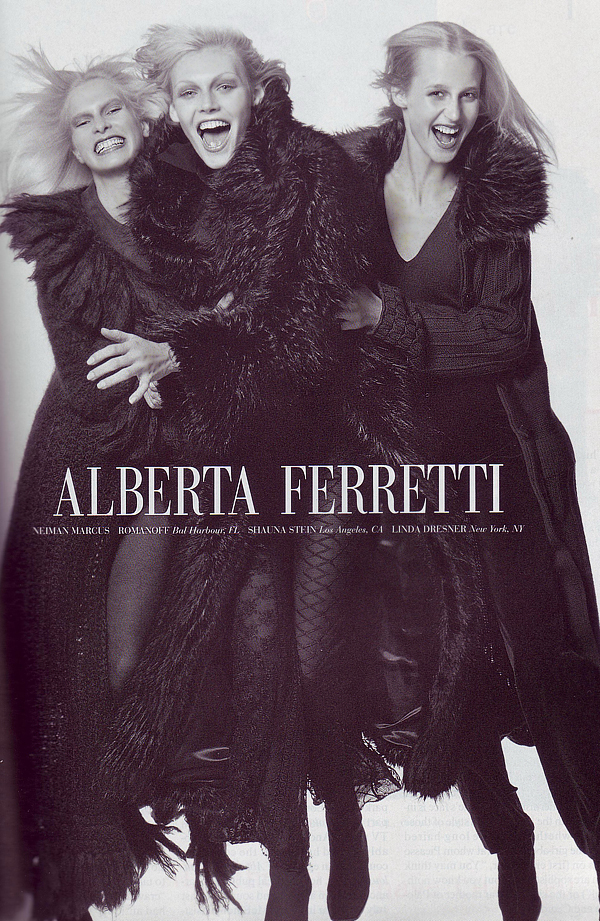
The initial stimulus of Alberta to deal with fashion was rather related to the motivation to make people happy by means of elegant outfits, to meet their needs and desires for beautiful and convenient clothing. The circumstance that she appears in the world of fashion as a trader first rather than a designer is curious, indeed. She was only eighteen when she opened her first boutique in Cattolica and started to sell outfits of other designers. However, once she launched some works of hers for sale and a sales representative caught sight of them and liked them. He immediately made her a seductive proposal to become more seriously involved with production and to allow him to sell her clothes in other shops across Italy. By offering in her boutique designs of Krizia, Armani, and Versace, she learnt from them many things about the design. Gradually the idea to start designing and to organize the production of clothes for other brands such as Moschino, Gaultier, Rodriguez, Ozbek matured. Currently, the designer has the opportunity to devote herself mainly to her artistic activity, since her brother Massimo Ferretti and her son Simone deal with her business. Alberta is now married to Giuseppe Campanella (an anesthesiologist and acupuncturist), and she has two sons from her first marriage, Simone and Giacomo.
„THE WOMAN IS THE PROTAGONIST”
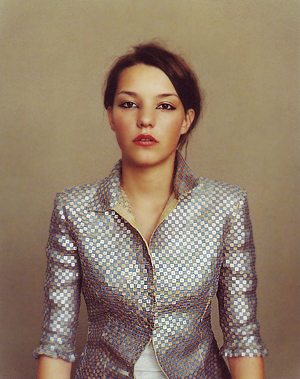 When the roots of the philosophy and the aesthetics, of the designer’s concept of Alberta Ferretti are sought, it would be inadmissible to neglect her concepts about the woman, about her system of values and role in society, family, profession and in life as a whole. Comparatively early she managed to become aware of the golden rule of every designer, i.e. that the designer has to have more respect for the woman and to follow her desires, understanding female body and its specifics. Ferretti claims with self-confidence and passion: “The dress is no longer the protagonist; the woman is. Now the dress must adapt itself to the woman. Both male and female designers have come to understand this. It's a question not of gender but of style and mentality.” Such a thesis should not be conceived as an attempt of the designer to underestimate the role of the dress, this classical attribute of woman's elegance. Her thinking is rather directed to the search of harmony, of the compliance between the individuality of a woman and the dress she wears. It is this that makes Ferretti define beauty as a unity between a dress and a woman.
When the roots of the philosophy and the aesthetics, of the designer’s concept of Alberta Ferretti are sought, it would be inadmissible to neglect her concepts about the woman, about her system of values and role in society, family, profession and in life as a whole. Comparatively early she managed to become aware of the golden rule of every designer, i.e. that the designer has to have more respect for the woman and to follow her desires, understanding female body and its specifics. Ferretti claims with self-confidence and passion: “The dress is no longer the protagonist; the woman is. Now the dress must adapt itself to the woman. Both male and female designers have come to understand this. It's a question not of gender but of style and mentality.” Such a thesis should not be conceived as an attempt of the designer to underestimate the role of the dress, this classical attribute of woman's elegance. Her thinking is rather directed to the search of harmony, of the compliance between the individuality of a woman and the dress she wears. It is this that makes Ferretti define beauty as a unity between a dress and a woman.
If, although conditionally, we take a look in the laboratory of the designer, we will see quite an active presence of fabrics such as silk, jersey, well processed wool, chiffon, cotton, among others. Crystals, beads, gems and semi-gems, with which she decorates her works, have their own place there. The ethereality and dynamics of the collections are to a great extent the aesthetic result of the well-measures use of embroideries and pleats, fresh colours and beautiful decorations.
The aesthetic views of Alberta Ferretti about the beauty and elegance in the fashion design show the philosophy of a strong woman of clearly expressed character. She does not hesitate to turn down fashion, which tries to manipulate women. Only when fashion starts to treat people as living creatures rather than passive things, normality occurs, the designer thinks. Due to this realism and this respect to the essential needs of the modern women, the fashion design becomes more harmonious, more original, more practical and more interesting.
Due to the conventional claims that the designer is a dictator and the fashion – power, Ferretti thinks that the most important thing is the freedom of choice. This is the way she explains the reason, which has made her to create her Philosophy line. A line, which possesses youth's spirit, allows many experiments and is directly associated with freedom. Lightness is among the key words that characterize the works of the famous Italian designer. Alberta herself points out lightness as an end result from her work, as the greatest advantage of her outfits. It is actually the lightness, which speaks for high professionalism, unusual sense of form, perfection in the choice of quality fabrics and precise combination of colours. Delicacy and exquisiteness are other definitions about the style of the designer. However, they are also the main prerequisites for the most important feature of her fashion – lightness. The designer herself says: “It’s not only the lightness of materials like chiffon. Lightness can come from something heavier like boiled wool. Lightness can be in the workmanship…”
Alberta Ferretti demonstrates real universality regarding sources of inspiration. She may receive an impulse for work from everything she sees, from everything, which is surrounding her, from everything she feels and touches – in direct or abstract sense - these could be clouds and skies or the gestures and mimics of some woman. While she works on her next collection and makes sketches of her new works, she tries to give the silhouette in movement and is aware that she creates a story, which should be told in an appropriate way.
“DIFFERENCE IS MORE REWARDING THAN HOMOLOGATION”
There is almost no interview of Alberta Ferretti, where she is not making a psychological or cultural dissection of the modern woman. Ferretti is not thinking at all that her style is universal for all representatives of the fair sex. She prefers to dress inquisitive women who try to be beautiful. For her, it is the charm that makes one woman different from the others. According to Alberta, fascination is doubtlessly due to the sexuality of a woman; however, it is the one, which demonstrates her freedom and independence. „I'm tired of women that dress according to precise rules,” she is sincere with journalists. “I do prefer a woman that knows how to impress through her originality because difference is more rewarding than homologation. Today homogeneity makes us find the same things at every corner of the world. Everything looks exactly the same. Even the women that have always known that differentiation is a reward, today look and dress in a very similar way anywhere. I like to believe that fashion is able to feed and solicit the fantasy which today is not very expressed.” Lots of ladies, who put on, without thinking, anything that glossy magazines and expensive shop windows offer them, should listen to the advice and criticism of Alberta Ferretti. The designer claims that the most important thing is to discover individuality, to find the magic key to difference, and this means – to the uniqueness of woman’s appearance.
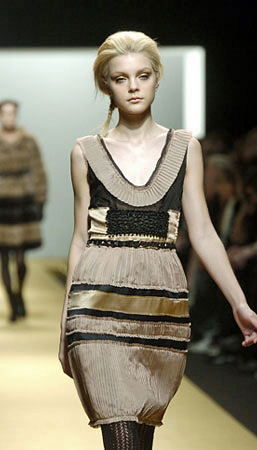
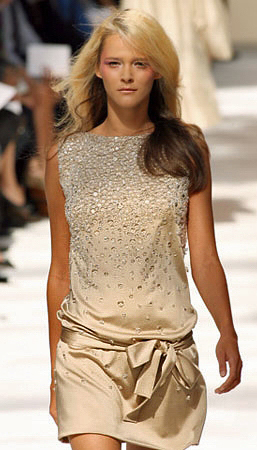
Ferretti is not hiding her attraction to the dynamic design and the idea about speed, about fastness. Because of that, she relied so much on fringes in one of her last collections – spring-summer 2009. Their versatility creates the sense of freedom and independent outburst. Free-falling, mono coloured, printed, with layers of chiffon, or with crocheted decorations - her fringes give the impression of vibrating rhythm and changing volumes. Fringes, processed by means of laser, which form an elongated and clean silhouette – these are part of the new messages of the style of Ferretti. The designer herself prefers soft tones and is definitely aware of the fact that fringes create movement and apparent disorder, however it has an effect on the imagination and brings a sense of lightness, perception of something new. This is how she herself describes her summer collection for 2009: “The shape instead is linear and clean. Straight dresses, the comeback of thin trousers, short on the ankle, shorts to be worn under mini-dresses, pencil skirts and long dresses with flat shoes or high heels: everything contributes to build a new silhouette, more complex, with the chance to add (a jacket, a bustier and a cape) but also to remove and simplify.”
A proof for the conceptual explicitness, or put otherwise, for the explicit conceptuality of Ferretti, is her thesis that only women could make clothes for women. Even if such claim is disputable, it deserves respect as it is satiated with personal experience in both life and creation. The designer has been impressing experts and fans with her enchanting dresses, emblematic coats and beautiful knitwear, which, without any alternative, underlines the forms of the women’s body without hindering its movements. Romanticism and luxury, femininity and sex appeal, boy’s emanation and the unisex consonant with it – these are only a small portion of the emotional scale, only a small part of the palette of sensations, caused by the works of Alberta Ferretti. We should not miss adding her precise performance of details and the special emphasis she puts on embroidery and different decorations.
OTHER OUTBURSTS OF TALENT
The gift of Alberta Ferretti shoots up in many directions – in interior and exterior design, architecture, perfumes, jewellery, restoration, hotel-keeping, and as a whole – the sensation about space and the skill to make it conceptual, sentimental, sacral. When, for example, she decided to open a Philosophy boutique in New York in 1998, she decided that the place will be in SoHo and nowhere else. In an interview at that time, the designer says that this was her favourite borough of New York, which is closest to her own personality, to her sense of dynamics, of difference and of urbanite charm. “What’s beautiful about SoHo, I think, is that you can actually see the sky. The building we are moving into is right beside the Rizzoli bookstore, that I’ve always seen in movies and photographs. For me it’s like a monument”. These reflections of Ferretti show the sensitivity of an artist, of a sculptor, of an architect… Ten years later, the designer is still devoted to her American love. In 2008 she opened a new boutique in the USA, this time in Hollywood rather than in New York. The glossy store is located on an area of 4,500 sq feet on Melrose Avenue in Los Angeles in the neighbourhood of the boutiques of famous French Balenciaga Fashion House and of British designer Alexander McQueen. It offers all collections of Alberta Ferretti, including her cheaper lines Philosophy di Alberta Ferretti and Alberta Ferretti Girl.
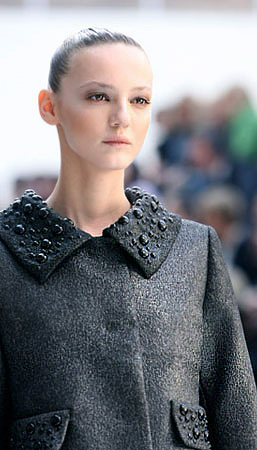
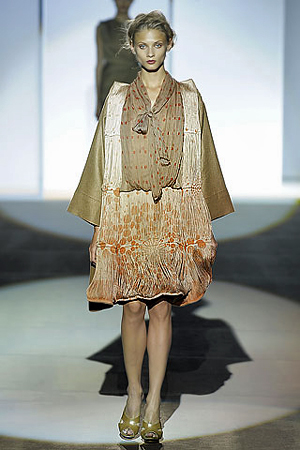
The cases happening more frequently recently, when famous designers such as Christian Lacroix, Giorgio Armani and Karl Lagerfeld, for example, establish and open hotels, should be accepted not as a logical creative dynamics and search for new fields of realization rather than the next mania. Alberta Ferretti is not an exception in this respect, she has even gone further, by deciding to restore a whole castle located in the neighbourhood of her native place between Rimini and Sant’Urbano. In 1991, the designer bought a locality and a settlement named Montegridolfo, whose greatest sight is a neglected castle from the 14th century. Within three years only, she managed to restore it and to turn it into a cultural and entertainment landmark, from which there was a wonderful view to the Adriatic Coast. Nowadays, the four-star hotel is called Palazzo Viviani and thanks to its authentic luxury is an attractive and desired tourist site for guests from all over the world.
RECOGNITION BY STARS
It is irrelevant to explain flirts and relations between designers and celebrities from the screen or pop-scene only with market, commercial and financial motifs. It is true that when a famous Hollywood star or a showbiz star wears an outfit by a certain designer, this is an advertising, which cannot be compared to anything else and infects with the new image thousands and millions of its fans. It is true that such acts are often agreed, bartered and even earnest is paid in advance. However, it is also true that both film stars and pop-icons are persons of refined feeling of modernity and that, in the long run, they make the choice, they give the due to one or another stylist. Alberta Ferretti fans include Madonna, Uma Thurman, Julia Roberts, Sarah Jessica Parker, Nicole Kidman, Andie McDowell and many others. Uma Thurman, for example, preferred to attend the Academy Awards ceremony in a red outfit by Ferretti, which attached her not only exquisite sex appeal, but also an unavoidable doze of formal elegance, or said otherwise, elegant formality.
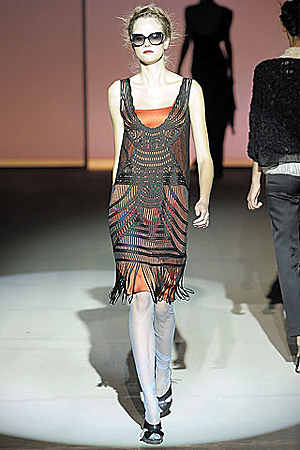
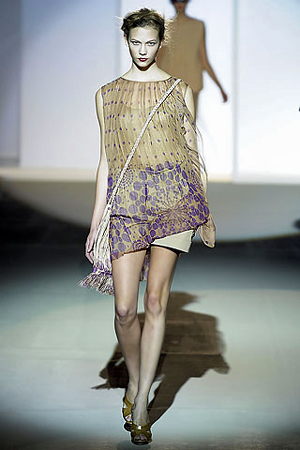
The originality and magnetism of the Ferretti could be seen in the outfits worn by one of the most popular pop stars nowadays, Madonna. Ferretti created her costumes for the 2002 romantic comedy Swept Away. This was not the first case when the designer created film costumes, however she remembers well one of the outfits for the main scenes of this Italian-British production”. "It was a caftan, and she [Madonna] had to keep falling off a yacht into the water. So of course that meant lots of caftans," Ferretti told Women's Wear Daily.
* * *
The Italian fashion is vivid and attractive, as it is created and developed by artists such as Alberta Ferretti. By personalities with delicate sensitivity and with a sense for aesthetic and market niches. What makes Ferretti a privileged artist of both national and world importance is her conceptual thinking and categorical underlining of the dominating role of woman in the choice of her appearance, in following a specific type of behaviour and fashion culture. The message of the famous designer cannot be understood, if her view about lightness as a key category in the fashion design is not realized. The femininity, romanticism and ethereality of her collections are due to her high professionalism, to her ability to search and find harmony between woman’s body and clothing. Alberta Ferretti is doomed to be successful, because she is a creator with character and will and never stops to go forward, as she says, defending her concept about femininity and elegance. Tender and sensitive in her realism, she really deserves recognition for her contribution to the creation of a more adequate, more exquisite ladies’ fashion.
Reference:
The following sources have been used: Alberta Ferretti Biography. In: www.notablebiographies.com. Baldini Castroldi Dalai editore, Inc., New York, 2006; Fashion now. i-D selects the world’s 150 most important designers. Edited by Terry Jones & Avril Mair. – Köln: Taschen, 2005; Sischy, Ingrid. Ferretti-to-wear. Interview, Oct., 1998. In: findarticles.com; www.net-a-porter.comi; www.net-a-porter.com; www.vogue.co.uk; www.style.com and other publications in Bulgarian and foreign media.
Photos:
1.Alberta Ferretti
Photo: © Fashion now. i-D selects the world’s 150 most important designers. Edited by Terry Jones & Avril Mair. – Köln: Taschen, 2005.
2. Collection of Alberta Ferretti, 1996
Photo: © Vogue (USA), October, 1966.
3. Collection Philosophy di Alberta Ferretti, March 2000
Photo: © Amber Rowlands / Styling Soraya Dayani / Fashion now. i-D selects the world’s 150 most important designers. Edited by Terry Jones & Avril Mair. – Köln: Taschen, 2005.
4. Collection of Alberta Ferretti, Autumn-Winter 2006-2007
Photo: © Giovanni Pucci
5. Collection of Alberta Ferretti, Spring-Summer 2007
Photo: © Giovanni Pucci
6. Collection of Alberta Ferretti, Autumn-Winter 2007-2008
Photo: © Giovanni Pucci
7. – 9. Collection of Alberta Ferretti, Spring-Summer 2009
Photo: © Marcio Madeira / Style.Com
Translator: Reny Ivanova
Read: 10153 times © Fashion Lifestyle Magazine, issue 24, July 2009
MORE PUBLICATIONS:ISSUE 23: SALVATORE FERRAGAMO: the shoemaker of the stars
ISSUE 22: LUCIANO BENETTON - the uniting innovator
ISSUE 20: CHRISTIAN DIOR: THE ULTIMATE ROMANTISISM OF THE NEW OUTLOOK
ISSUE 18: ANNA MOLINARI: “MY CLOTHES BRING MESSAGE OF BEAUTY AND SEDUCTION"
ISSUE 17: VIKTOR & ROLF: CONCEPTUAL DUO FOR MILLIONS





